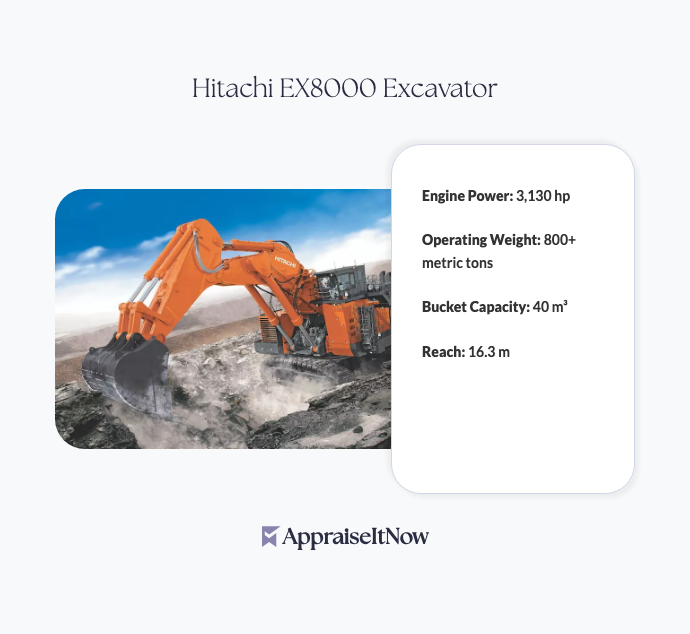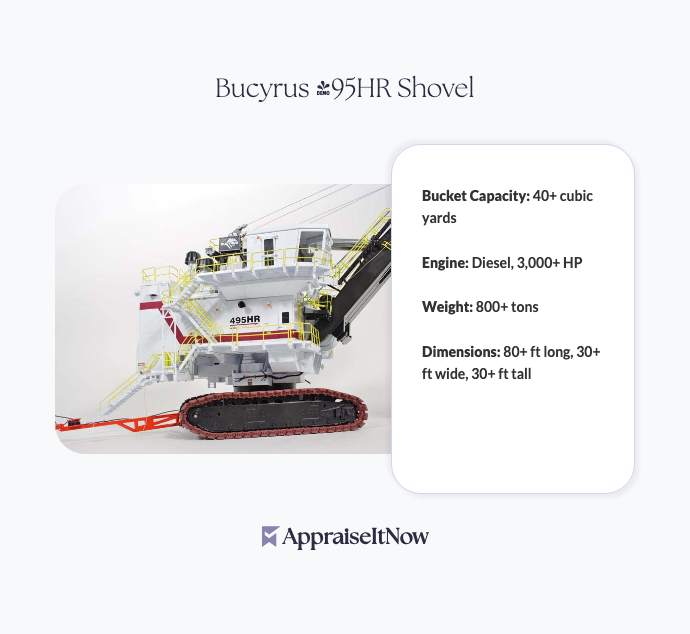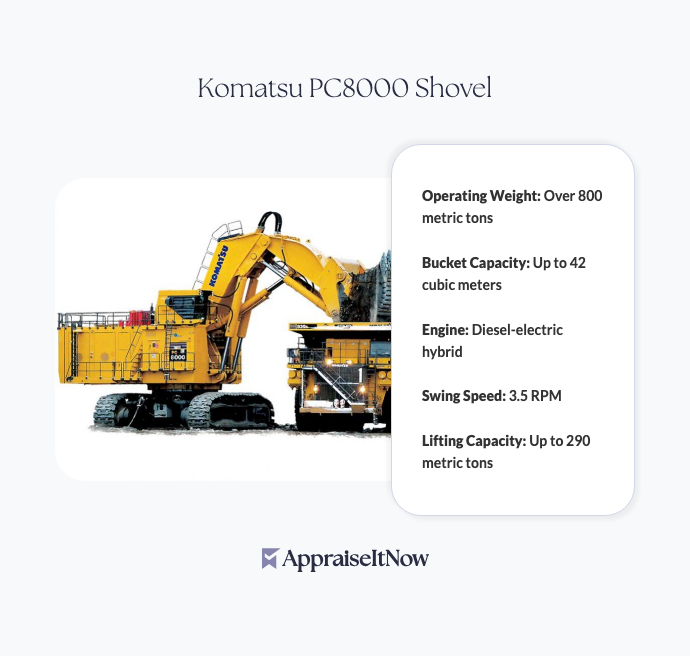<h1>How to Get Your Hitachi EX8000 Excavator Appraised</h1>
<p>The Hitachi EX8000 excavator represents one of the most formidable pieces of heavy machinery in the world today. With a market valuation between <strong>$700,000 and $800,000</strong>, understanding what influences this significant asset's worth is essential whether you're buying, selling, or managing your equipment portfolio. Getting a professional appraisal ensures you have accurate, defensible documentation for any transaction or insurance purpose.</p>
<h2>Understanding Your Hitachi EX8000's Value Drivers</h2>
<p>Your EX8000 isn't just another excavator—it's a purpose-built machine designed specifically for large-scale mining and construction operations. Operating at over <strong>800 metric tons</strong>, this hydraulic powerhouse generates <strong>3,130 horsepower</strong> and can handle <strong>40 cubic meter bucket capacities</strong> with a reach extending <strong>16.3 meters</strong>. These specifications position it in the premium segment of <a href="/types/heavy-machinery">heavy machinery</a> valuation, where even minor condition variations can shift value by tens of thousands of dollars.</p>
<p>The original 1990 design combined cutting-edge hydraulic engineering with heavy-duty steel construction that has proven itself across mining operations worldwide. What makes your EX8000's market price meaningful? Its ability to efficiently move massive amounts of overburden and ore while maintaining fuel efficiency keeps demand strong among contractors managing large-scale projects. The spacious, comfortable cab—a feature often overlooked but highly valued by operators—contributes to both productivity and resale appeal.</p>
<h2>Age, Condition, and Market Positioning</h2>
<p>When evaluating how much a Hitachi EX8000 costs today, consider that this machine first launched in 1990, making older units now entering their fourth decade of potential service. However, the EX8000's robust construction means many units still operate effectively, and those properly maintained command strong valuations. A 2005 model in excellent condition might fetch closer to <strong>$750,000</strong>, while a machine from the early 1990s with significant wear history could drop toward <strong>$500,000-$600,000</strong>.</p>
<p>Your machine's service history becomes the defining factor in professional appraisal. Has the unit undergone regular maintenance with documented service records? Have major hydraulic systems been rebuilt or replaced? What's the condition of the cab controls and operator safety features? Professional appraisers specializing in <a href="/types/construction-equipment">construction equipment</a> examine these granular details using established protocols to justify the valuation range.</p>
<div class="callout tip"><p><strong>Valuation Insight</strong></p>
<p>Machines with verified maintenance records and documented operating hours typically command 15-25% premiums over units with unclear service histories, even when physical condition appears similar.</p></div>
<h2>Comparing the EX8000 to Competitive Models</h2>
<p>Understanding how your Hitachi EX8000 stacks against competing models helps position its value accurately. When comparing the Hitachi 5600 and 8000, the differences become immediately apparent: the EX5600 operates at approximately 530 metric tons with a 28 cubic meter bucket, making it suitable for mid-range mining operations. The EX8000's substantially larger capacity means it commands proportionally higher valuations, though not necessarily linear price increases. The efficiency gains from handling material in fewer passes often justify the cost differential for operators managing high-volume extraction.</p>
<p>The broader question of whether Hitachi machinery competes favorably against Komatsu reflects market dynamics worth understanding. Both manufacturers produce comparable ultra-heavy excavators, and professional appraisers consider this competitive landscape when establishing fair market value. Komatsu's PC8000 model, for instance, operates in similar capacity ranges, and relative pricing between brands influences your EX8000's ultimate valuation. An experienced appraiser familiar with both manufacturers' specifications and market reception will position your machine appropriately against these alternatives.</p>
<h2>Physical Specifications That Matter to Appraisers</h2>
<p>Beyond the headline <strong>$700,000-$800,000 range</strong>, specific technical details significantly influence individual valuations. The EX8000's bucket capacity of 40 cubic meters represents genuine competitive advantage in bulk material handling, while the <strong>16.3-meter reach</strong> allows operators to efficiently manage steep pit walls and deep excavation scenarios. These aren't academic specifications—they directly translate to reduced cycle times, lower fuel consumption per ton moved, and superior operator sight lines.</p>
<p>The hydraulic system deserves particular attention during appraisal. How efficiently does hydraulic pressure maintain under maximum load? Are hose conditions acceptable, or do they show signs of deterioration that would necessitate expensive replacement? What about the engine? The original 3,130 horsepower specification assumes peak condition, but real-world assessments examine compression ratios, valve timing, and fuel injection precision to determine if your unit still delivers peak performance or has experienced degradation requiring costly repairs.</p>
<h2>Weight Specifications and Operational Implications</h2>
<p>How much does a Hitachi EX8000 weigh? The operating weight exceeding <strong>800 metric tons</strong> represents a critical specification affecting site feasibility and operational costs. This substantial mass requires dedicated heavy transport capabilities, specialized rigging equipment, and prepared foundation systems. When you're considering an EX8000 purchase or sale, understanding these logistical implications helps appraisers assess regional demand and consequently influence valuations. Machines in regions with robust heavy equipment infrastructure may command slight premiums over identical units in areas requiring specialized mobilization arrangements.</p>
<h2>Assessing Excavator Lifespan and Depreciation Patterns</h2>
<p>What is the lifespan of a massive excavator like the EX8000? Well-maintained units regularly operate for <strong>15-20 years</strong> or longer, with many examples still functioning effectively 30+ years after manufacture. However, this extended serviceable life doesn't translate to stable valuations. Rather, the depreciation curve for equipment of this class typically shows steepest value declines in the first 5-7 years, then stabilizes somewhat as machines transition from primary production equipment to specialized or secondary applications.</p>
<p>Your EX8000's remaining useful life significantly influences appraisal methodology. A 1995 model still producing strong service might warrant valuation based on income potential or production capability, similar to how we approach <a href="/types/business-assets">business asset valuations</a>. Conversely, a recent model would justify valuations based primarily on comparative market analysis with similar-year machines. Professional appraisers understand these methodological distinctions and apply appropriate frameworks based on your specific machine's circumstances.</p>
<div class="callout note"><p><strong>Depreciation Pattern</strong></p>
<p>EX8000 machines typically retain 60-70% of their original cost after 5 years, then depreciate roughly 5-8% annually through year 15, with rates stabilizing thereafter for well-maintained units.</p></div>
<h2>Engine Specifications and Performance Verification</h2>
<p>What engines do Hitachi excavators use, and how does this affect valuation? Your EX8000's 3,130 horsepower engine represents proprietary Hitachi engineering optimized specifically for the massive weight and load demands of this class machine. Unlike smaller <a href="/types/construction-equipment">construction equipment</a>, ultra-heavy excavators cannot simply substitute comparable engines—proper performance requires precise matching of engine output to hydraulic system capacity and bucket load specifications.</p>
<p>During appraisal, specialists verify engine performance through compression testing, fuel system evaluation, and operational observation under load. An engine demonstrating full power output through the entire RPM range commands premium valuations. Any evidence of derating, reduced horsepower output, or fuel efficiency degradation requires adjustment downward from baseline assumptions. This technical assessment mirrors methodology used in <a href="/blog/the-basics-of-equipment-and-machinery-appraisal">equipment and machinery appraisals</a> across all industrial categories.</p>
<h2>Market Demand and Geographic Considerations</h2>
<p>The question of whether the biggest excavator you can buy justifies premium pricing admits a nuanced answer. The EX8000 represents the upper tier of conventional bucket-and-boom technology, though specialized applications occasionally employ even larger rope or continuous bucket systems. However, for traditional excavator markets, the EX8000's position creates steady demand from mining operations, heavy construction contractors, and quarrying enterprises.</p>
<p>Geographic market dynamics substantially influence your specific machine's valuation. EX8000 units situated in active mining regions—Western Australia, Canada's resource provinces, or major U.S. coal and mineral operations—typically command values at the higher end of the range. Machines located in regions with declining resource extraction may see valuations trending toward the $700,000 baseline. Professional appraisers thoroughly understand these regional economic factors and adjust valuations accordingly.</p>
<h2>Hitachi's Market Position and Brand Considerations</h2>
<p>Understanding Hitachi's evolution helps contextualize your machine's value. The question of why Hitachi is changing its name sometimes arises among equipment managers, reflecting the company's corporate restructuring efforts in recent years. These corporate changes rarely affect individual machine valuations directly, though they may influence parts availability and service network robustness—factors that sophisticated appraisers consider when assessing future operational cost implications.</p>
<p>Hitachi's reputation for quality construction equipment remains strong globally, and the EX8000's successful 30+ year market presence validates this manufacturer's engineering. When comparing <a href="/blog/appraising-industrial-equipment-assessing-machinery-and-manufacturing-assets">industrial equipment</a> valuations across manufacturers, Hitachi machines consistently maintain competitive positioning against Komatsu, Liebherr, and Caterpillar alternatives, suggesting stable valuation frameworks for your equipment.</p>
<h2>Getting Your EX8000 Appraised: What to Expect</h2>
<p>A professional Hitachi EX8000 appraisal requires comprehensive evaluation encompassing physical inspection, documentation review, and market analysis. Appraisers specializing in <a href="/blog/the-basics-of-heavy-machinery-appraisal">heavy machinery</a> will examine mechanical systems, hydraulic integrity, structural condition, and operator amenities. They'll request maintenance records, original purchase documentation, and any service history available. The resulting report establishes defensible fair market value suitable for insurance coverage, sale transactions, or estate planning purposes.</p>
<p>The appraiser's credentials matter significantly. Look for professionals holding certifications through recognized organizations like <strong>AAA, ISA, ASA, CAGA, or AMEA</strong>, and ensure they possess specific expertise with <a href="/blog/appraising-industrial-equipment-assessing-machinery-and-manufacturing-assets">heavy construction equipment</a>. Services like <strong>AppraiseItNow</strong> connect you with credentialed experts across the U.S. who understand the specialized requirements for valuing machinery of this magnitude, ensuring your appraisal withstands professional scrutiny.</p>
<h2>Documentation and Valuation Support</h2>
<p>Beyond physical inspection, professional appraisals require comprehensive documentation supporting the valuation conclusion. Operating hour meters, service records, inspection reports, and any modifications or upgrades should be compiled and provided to the appraiser. This documentation transforms an appraisal from a subjective estimate into a defensible expert opinion grounded in verifiable facts and industry standards. The resulting <strong>USPAP-compliant appraisal</strong> provides documentation acceptable to insurance carriers, financial institutions, and courts.</p>
<div class="callout note"><p><strong>Key Takeaway</strong></p>
<p>A certified appraisal of your Hitachi EX8000 excavator provides authoritative documentation of its <strong>$700,000-$800,000 market value</strong>, ensuring accurate valuation for purchase decisions, insurance coverage, or sales transactions. Professional expertise transforms equipment assessment from guesswork into credible expert opinion grounded in rigorous analysis and industry standards.</p></div>







.avif)







